Physical Address
304 North Cardinal St.
Dorchester Center, MA 02124
Chapters 65 and 66 deal with various haematological conditions, both neoplastic and non-neoplastic, that may be manifest on imaging of the skeletal system. The recently updated 2016 World Health Organization (WHO) classification of myeloproliferative neoplasms is extremely complex and includes a variety of conditions of differing malignant potential. Only those that have any significant radiological manifestations in the skeletal system will be discussed.
Polycythaemia vera (PV) is a myeloproliferative neoplasm characterised primarily by erythrocytosis. The WHO diagnosis of PV includes major and minor criteria, the 3 major being: (1) raised haemoglobin levels (>16.5 g/dL for men and >16.0 g/dL for women or haematocrit >49% in men and >48% in women), (2) bone marrow biopsy showing hypercellularity of erythroid, granulocytic and megakaryocytic elements (pan-myelosis) with pleomorphic mature megakaryocytes, and (3) the presence of JAK2 V617ZF or JAK2 exon 12 mutation. The minor criterion is reduced erythropoietin level.
PV has an incidence of 1.5 to 2.0/100,000 and presents at a mean age of 50 to 55 years, being twice as common in females. Typical clinical manifestations include thrombosis, neurological symptoms, pruritis, plethora, and splenomegaly. Management includes regular phlebotomy to maintain a haematocrit of less than 45%, daily low-dose aspirin, and in high-risk patients, cytoreductive therapy. Median survival is approximately 14 years, and both fibrotic and acute myeloid leukaemic transformation are recognised, the latter in just under 10% of patients at 20 years post-diagnosis.
As with any condition resulting in marrow hyperplasia, magnetic resonance imaging (MRI) will demonstrate diffuse reduction of T 1 weighted marrow signal and hyperintensity on short tau inversion recovery (STIR), although focal marrow abnormality may also be seen. The progression to acute myeloid leukaemia (AML) may not be evident, unless the patient develops a myeloid sarcoma (see later). Non-skeletal manifestations include splenomegaly and signs of thrombosis.
Primary myelofibrosis (PMF) is a myeloproliferative neoplasm of unknown aetiology in which clonal proliferation of haematopoietic stem cells results in progressive bone marrow fibrosis, with consequent anaemia, splenomegaly, and extramedullary haematopoiesis (EMH). The diagnosis is based on demonstration of fibrosis at bone marrow biopsy, and is supported by a variety of genetic abnormalities, including JAK2 in 55%. The blood film may show pancytopenia with abnormal red blood cell morphology. Secondary myelofibrosis may also occur as a late complication of PV or, less commonly, essential thrombocytopenia, and this may be accelerated by drugs used to treat these conditions.
PMF has an incidence of 0.5 to 1.5/100,000 and affects men and women equally, presenting at a median age of 50 to 60 years. Clinical findings include weakness, dyspnoea and weight-loss due to progressive obliteration of the marrow by fibrosis or bony sclerosis, which leads to a moderate anaemia. There is also increased risk of infection and gout. EMH takes place in the liver and spleen, which become enlarged in 72% and 94% of cases respectively, but is also reported in lymph nodes, lung, choroid plexus, kidney, etc. The natural history is one of slow deterioration, with death typically occurring 2 to 3 years after diagnosis, although potential cure can be achieved with allogenic stem cell transplantation. Progression to leukaemia is also a feature.
Bone sclerosis is the major radiological finding, being evident in approximately 30% to 70% of cases. Typically, this is diffuse, but occasionally patchy ( Fig. 65.1A ), occurring most often in the axial skeleton and major long bone metaphyses. Sclerosis is due to trabecular and endosteal new bone ( Fig. 65.1B ), resulting in reduced marrow diameter. In established disease, lucent areas are due to fibrous tissue reaction. Periosteal reaction occurs in one-third of cases, most often in the medial aspects of the distal femur and proximal tibia. The skull may show a mixed sclerotic and lytic pattern, and bone scintigraphy can demonstrate a ‘superscan’ appearance.
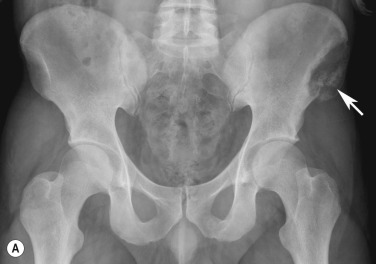
MRI typically demonstrates marrow hypointensity on both T 1 weighted and T 2 weighted sequences, which may be diffuse or heterogeneous ( Fig. 65.1C and D ). Additional features include arthropathy due to haemarthrosis and secondary gout, occurring in 5% to 20% of cases. Infiltration of the synovium by bone marrow elements may result in polyarthralgia and polyarthritis. Leukaemic conversion may manifest radiologically by the development of an extraosseous soft-tissue mass ( Fig. 65.1A ). MRI may also show regression of marrow changes following successful stem cell transplantation.
PMF is the commonest cause of EMH, usually resulting in hepatosplenomegaly. However, EMH may also present in the thorax as bilateral paravertebral masses or marked enlargement of the ribs, or as a pre-sacral mass. These lesions appear on computed tomography (CT) as non-calcifying soft tissue masses containing areas of fat ( Fig. 65.2A ), while MRI shows masses of heterogeneous T 1 weighted and T 2 weighted signal intensity ( Fig. 65.2B ). The presence of fat signal intensity may suggest that the masses are inactive, while enhancement may suggest that they are active.
Polycythaemia vera and primary myelofibrosis
Clinical features include presentation in adults with splenomegaly and extramedullary haematopoiesis (EMH)
Radiographs may show marrow sclerosis in myelofibrosis
Magnetic resonance imaging demonstrates features of marrow hyperplasia/fibrosis with diffuse or heterogeneous reduction of T 1 weighted marrow SI
EMH manifests as hepatosplenomegaly, thoracic paravertebral masses, rib enlargement, and pre-sacral masses
May transform to leukaemia
SI, signal intensity.
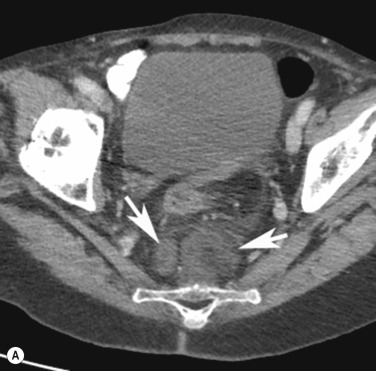
Leukaemia accounts for approximately 30% of all childhood malignancy, the vast majority being the acute form, which arises from immature leukocytes. Acute lymphocytic leukaemia (ALL) accounts for 75%, AML for 20%, and other types for 5% of cases. Chronic leukaemias arise from mature cell lines and predominate in adults, but sometimes terminate in an acute blastic form.
ALL usually presents in children at 2–3 years of age, while AML is most commonly seen in the first 2 years of life. The acute disease is often insidious, with nonspecific malaise, anorexia, fever, petechiae, and weight loss. Limb pain and pathological fracture are common. Bone pain at presentation is five times more common in children than adults, being reported in over 33% of cases. Adults are most commonly affected by chronic lymphatic leukaemia (CLL) and AML, with a reported incidence of 3–4%. Most skeletal lesions in adults affect sites of residual red marrow, the axial skeleton and proximal ends of the femora and humeri. CLL is a disease of the elderly, characterised by enlargement of the spleen and lymph nodes with skeletal involvement being rare ( Fig. 65.3 ), except as a terminal event.
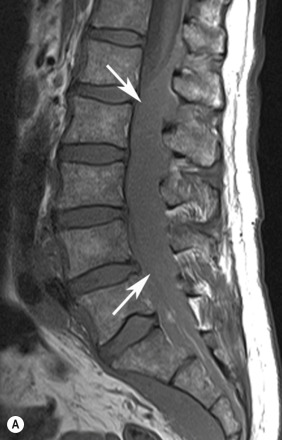
Radiological evidence of bone involvement in acute childhood leukaemia is reported in approximately 40% of patients at presentation, the incidence of the various features being as follows: osteolysis (13.1%), metaphyseal bands (9.8%), osteopenia (9%), osteosclerosis (7.4%), permeative bone destruction (5.7%), pathological fracture (5.7%), periosteal reaction (4.1%) and mixed lytic–sclerotic lesions (2.5%). Such changes will also be seen in up to 75% of children during the course of their disease.
Diffuse osteopenia is reported in 16–41% of cases and may be metabolic in aetiology, or due to diffuse marrow infiltration. The effects of corticosteroids and chemotherapy also contribute to osteoporosis. Compression fractures, including vertebra plana, occur in association with osteopenia of the spine.
Metaphyseal lucent bands primarily affect the distal femur, proximal tibia and distal radius, with other metaphyses and the vertebral bodies affected later. They are typically 2–15 mm in width ( Fig. 65.4A ). These changes may also be seen in generalised infection, typically in infancy; in children over the age of 2 years, leukaemia is more likely.
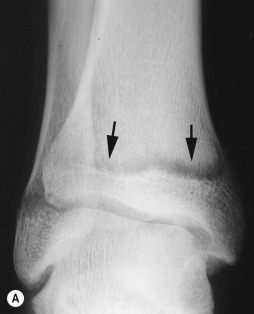
More extensive involvement results in diffuse, permeative bone destruction ( Fig. 65.4B ), like that seen in Ewing sarcoma. The cortex becomes eroded on its endosteal surface and may ultimately be destroyed. The permeative pattern is reported in 18% of leukaemic children. Osteolytic lesions secondary to bone destruction typically have a moth-eaten appearance and most commonly affect long bone metaphyses. Such lesions are reported in 10–40% of patients and predispose to pathological fracture. A particular focal lesion most commonly seen in AML is myeloid sarcoma (granulocytic sarcoma, chloroma), occurring in 2.5–9.1% of cases. It is usually located in the skull, spine, ribs, or sternum of children, and is an expanding tumour caused by a collection of leukaemic cells ( Fig. 65.4C ).
Osteosclerosis is rare, being reported in 6% of cases. Sclerotic changes in the metaphyses of long bones may occur spontaneously, or as a result of therapy. Mixed lytic-sclerotic lesions are identified in around 18% of children. Periosteal reaction is reported in 2–50% of cases and may occur in isolation or in association with destructive cortical lesions. It is due to sub-periosteal haemorrhage or proliferation of leukaemic deposits. Non-specific cortical destruction may involve the medial aspect of the proximal humerus, tibia and sometimes femur. In adults, skeletal lesions are less common and must be differentiated from metastases, or a primary malignant bone neoplasm.
MRI typically demonstrates diffuse reduction of T 1 weighted marrow signal intensity ( Fig. 65.5A ) and increased signal intensity on fat suppressed T 2 weighted/STIR sequences ( Fig. 65.5B ), or less commonly patchy marrow infiltration ( Fig. 65.5C ), with marrow enhancement following contrast ( Fig. 65.5D and E ). A change from normal to nodular to diffuse low signal intensity can be seen with disease progression, together with an increase in the extent of signal intensity abnormality, but there is no consensus on the use of MRI for the staging of leukaemia. Response to therapy is also demonstrable with disease remission, being associated with a return to normal marrow signal intensity. Bone marrow relapse may manifest as well-defined nodules, and relapse may also occur in extra-medullary sites such as skeletal muscle. MRI can identify complications of treatment such as osteonecrosis ( Fig. 65.6 ), which is reported in 6.5–15% of cases. Marrow necrosis may also occur due to microvascular occlusion, and manifests as a geographic area of peripheral marrow enhancement with a non-enhancing centre. Marrow necrosis may heal. Myeloid sarcoma manifests on MRI as an extra-osseous mass which is isointense on T 1 weighted but hyperintense to muscle on PDW/T 2 weighted ( Fig. 65.7 ), and which enhances avidly following contrast.
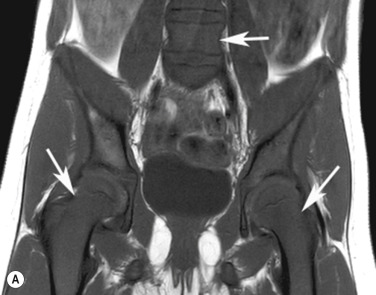
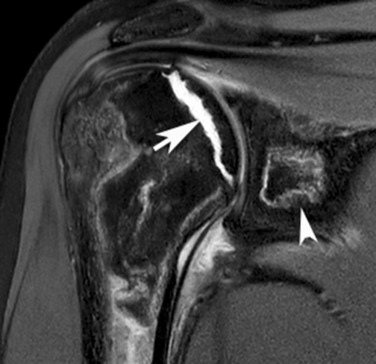
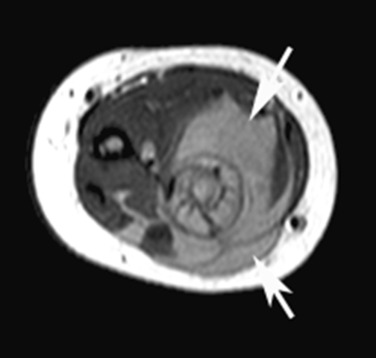
Focal or diffuse increased uptake on fluorodeoxyglucose (FDG) positron emission tomography (PET)/CT may be seen in leukaemia, but is nonspecific, since abnormal activity may also be seen following chemotherapy or the use of granulocyte colony–stimulating factor (GCSF).
Approximately ![]() of childhood malignancy, usually ALL (75%) or AML (20%)
of childhood malignancy, usually ALL (75%) or AML (20%)
Radiological abnormality in 40% at presentation; osteolysis, metaphyseal bands, osteopenia, osteosclerosis, bone destruction, pathological fracture
Magnetic resonance imaging demonstrates diffuse reduction of T 1 weighted marrow SI with corresponding hyperintensity on short tau inversion recovery (STIR)
Skeletal complications include osteonecrosis
May develop a focal mass of leukemic cells termed myeloid sarcoma
ALL , Acute lymphocytic leukaemia; AML , acute myeloid leukaemia.
Become a Clinical Tree membership for Full access and enjoy Unlimited articles
If you are a member. Log in here